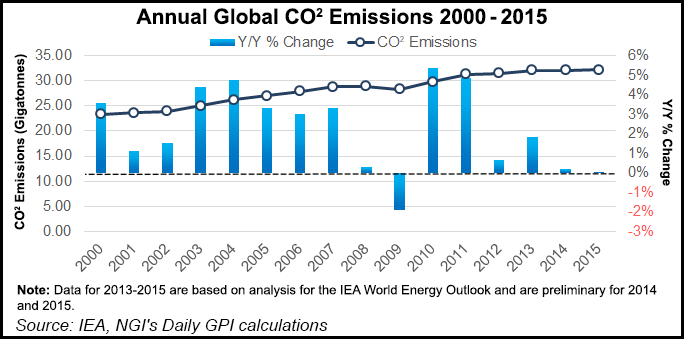NGI Archives | NGI All News Access | NGI The Weekly Gas Market Report
U.S. Carbon Emissions Decline 2% as NatGas Use Expands, Says IEA
Global energy-related carbon dioxide (CO2) emissions, considered the largest source of man-made greenhouse gas emissions, remained flat in 2015 for the second year in a row, in part on the rising use of natural gas, according to an analysis of preliminary data by the International Energy Agency (IEA).

“The new figures confirm last year’s surprising but welcome news: we now have seen two straight years of greenhouse gas emissions decoupling from economic growth,” said IEA Executive Director Fatih Birol.
The news comes only a few months after a landmark global emissions agreement in Paris (see Daily GPI, Dec. 14, 2015). Birol said the latest data “is yet another boost to the global fight against climate change.”
The two largest CO2 emitters, China and the United States, each registered a decline in emissions last year.
“In the United States, emissions declined by 2%, as a large switch from coal to natural gas use in electricity generation took place,” IEA noted. In China, CO2 emissions fell by 1.5% last year as coal use dropped for the second year in a row.
Natural gas, which surpassed coal’s share of U.S. power generation for the first time ever last spring, is likely to make 2016 the first year that gas-fired generation exceeds coal generation in the United States on an annual basis, according to the Energy Information Administration (see related story).
Global CO2 emissions stood at 32.1 billion metric tons in 2015, essentially flat since 2013. Electricity generated by renewables “played a critical role, having accounted for around 90% of new electricity generation in 2015,” researchers said. “In parallel, the global economy continued to grow by more than 3%, offering further evidence that the link between economic growth and emissions growth is weakening.”
In the more than 40 years in which the IEA has been providing information on CO2 emissions, only four periods saw emissions remain flat or decline from previous years. Three of those — the early 1980s, 1992 and 2009 — were associated with global economic weakness.
However, the recent stall in emissions comes amid economic expansion. According to the International Monetary Fund, global gross domestic product grew by 3.4% in 2014 and 3.1% in 2015.
The decline in CO2 emissions in the United States and China was offset by increasing emissions in most other Asian developing economies and the Middle East, as well as a moderate increase in Europe.
© 2024 Natural Gas Intelligence. All rights reserved.
ISSN © 1532-1231 | ISSN © 2577-9877 | ISSN © 1532-1266 |
